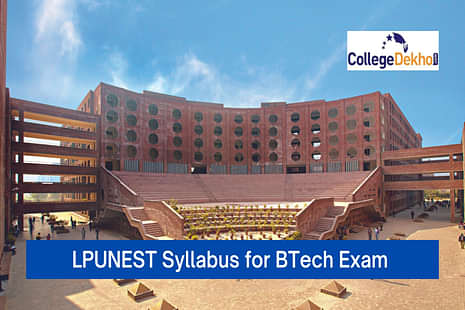
LPUNEST 2026 Syllabus for BTech Exam : LPUNEST B.Tech syllabus 2026 has been released by Lovely Professional University on its official website. As per the B.Tech syllabus of LPUNEST 2026, it comprises Mathematics, Physics, Chemistry, English and Biology. Candidates can choose the subject combination of Mathematics, Physics, Chemistry and English or Physics, Chemistry, Biology and English for the B.Tech course. To prepare well for the LPUNEST exam every candidate must follow the syllabus of LPUNEST thoroughly.
The LPUNEST 2026 exam will have a total of 100 questions ( 20 multiple-choice questions for PCM and 5 fill-in-the-blank questions), with each question carrying four marks, and there will be no negative marking for incorrect answers. Candidates who clear the LPUNEST 2026 exam will be eligible for admission to Lovely Professional University's undergraduate engineering courses and can also avail of scholarships based on their performance in the exam. The direct links to download the LPUNEST 2026 syllabus PDF are available on this page. In this article, we will take a detailed look at the LPUNEST 2026 syllabus for BTech exam, topic-wise syllabus.
LPUNEST 2026 B.Tech Syllabus PDF
Students can click on the direct links mentioned below to download the LPUNEST 2023 syllabus in PDF format.
Subject | PDF Download |
|---|---|
| Mathematics | LPUNEST 2026 Maths Syllabus PDF |
| Physics | LPUNEST 2026 Physics Syllabus PDF |
| Chemistry | LPUNEST 2026 Chemistry Syllabus PDF |
| Biology | LPUNEST 2026 Biology Syllabus PDF |
| English | LPUNEST 2026 English Syllabus PDF |
LPUNEST Physics Syllabus 2026
To ensure comprehensive preparation for the Physics section in LPUNEST 2026 BTech exam, students can check the detailed LPUNEST 2026 physics syllabus topic-wise table below. It provides a structured approach to cover all the important concepts and topics in this section.
Units | Detailed topics |
|---|---|
Unit 1 - Laws Of Motion |
|
Unit 2 - Work, Energy, And Power |
|
Unit 3 - Rotational Motion |
|
Unit 4 - Physics And Measurement |
|
Unit 5 - Kinematics |
|
Unit 6 - Gravitation |
|
Unit 7 - Oscillations And Waves |
|
Unit 8 - Properties Of Solids And Liquids-I |
|
Unit 9 - Thermodynamics |
|
Unit 10 - Kinetic Theory Of Gases |
|
Unit 11 - Electrostatics-I |
|
Unit 12 - Electrostatics-Ii |
|
Unit 13 - Current Electricity |
|
Unit 14 - Magnetic Effects Of Current And Magnetism |
|
Unit 15 - Atoms And Nuclei |
|
Unit 16 - Dual Nature Of Matter And Radiation |
|
Unit 17 - Optics-I |
|
Unit 18 - Optics-Ii |
|
Unit19 - Electromagnetic Induction And Alternating Currents |
|
Unit 20 - Electronic Devices |
|
Unit 21 - Electronic Devices-Ii |
|
Unit 22 - Electromagnetic Waves |
|
Unit 23 - Communication Systems |
|
LPUNEST 2026 Chemistry Syllabus
For thorough preparation of the LPUNEST 2026 BTech exam Chemistry section, candidates can refer to the detailed topic-wise table below. It provides a systematic overview of all the important concepts and topics covered in this section.
Units | Detailed LPUNEST 2026 Chemistry Syllabus |
|---|---|
UNIT 1: Some Basic Concepts in Chemistry |
|
UNIT 2: States of Matter |
|
UNIT 3:Atomic Structure |
|
UNIT 4: Chemical Bonding and Molecular Structure |
|
UNIT 5: Chemical Thermodynamics |
|
UNIT 6: Solutions |
|
UNIT 7: Equilibrium |
|
UNIT 8: Redox Reactions and Electrochemistry |
|
UNIT 9: Chemical Kinetics |
|
UNIT 10: Surface Chemistry |
|
UNIT 11: Classification of Elements and Periodicity in Properties |
|
UNIT 12: General Principles and Process of Isolation of Metals |
|
UNIT 13: Hydrogen | Position of Hydrogen in the periodic table, isotopes, preparation, properties and uses of Hydrogen; Physical and chemical properties of water and heavy water; Structure, preparation, reactions and uses of Hydrogen peroxide; Classification of Hydrides - ionic, covalent and interstitial; Hydrogen as a fuel. |
UNIT 14: s - Block Elements (Alkali and Alkaline Earth Metals) |
|
UNIT 15: p - Block Elements |
|
Group - 13 |
|
UNIT 16: p - Block Elements |
|
Group 16 to Group 18 Elements |
|
UNIT 17: d – and f – Block Elements: |
|
UNIT 18: Co-ordination Compounds |
|
UNIT 19: Environmental Chemistry |
|
UNIT 20: Purification and Characterization of Organic Compounds |
|
UNIT 21: Some Basic Principles of Organic Chemistry-I |
|
UNIT 22: Hydrocarbons |
|
UNIT 23: Organic Compounds Containing Oxygen-I |
|
UNIT 24: Organic Compounds Containing Oxygen-II |
|
UNIT 25: Organic Compounds Containing Nitrogen: |
|
UNIT 26: Polymers |
|
UNIT 27: Practical Chemistry |
|
UNIT 28: Chemistry in Everyday Life |
|
UNIT 29: Bio Molecules |
|
UNIT 30: Stratospheric pollution |
|
LPUNEST 2026 Mathematics Syllabus
Candidates can use the detailed LPUNEST 2026 Mathematics syllabus topic-wise table below as a reference. It covers all the essential topics and concepts, ensuring comprehensive preparation for this section.
Units | Subtopics |
|---|---|
UNIT 1: Sets | Sets and their representation; Union, intersection and complement of sets and their algebraic properties; Power set. |
UNIT 2: Relations | Relation, Types of relations, equivalence relations. |
UNIT 3: Function, limit and Continuity |
|
UNIT 4: Complex numbers | Complex numbers as ordered pairs of reals, Representation of complex numbers in the form a+ib and their representation in a plane, Argand diagram, algebra of complex numbers, modulus and argument (or amplitude) of a complex number, square root of a complex number, triangle inequality. |
UNIT 5: Quadratic equations | Quadratic equations in real and complex number system and their solutions. Relation between roots and coefficients, nature of roots, formation of quadratic equations with given roots. |
UNIT 6: Sequences and series | Arithmetic and Geometric progressions, insertion of arithmetic, geometric means between two given numbers. Relation between A.M. and G.M. Sumupto n terms of special series, Geometric progression. |
UNIT 7: Matrices | Matrices, algebra of matrices, types of matrices, matrices of order two and three; Adjoint; transpose; symmetric and skew-symmetric matrices. |
UNIT 8: Determinants |
|
UNIT 9: Vector algebra | p, addition of vectors, components of a vector in two dimensions and three-dimensional space, scalar and vector products, scalar and vector triple product. |
UNIT 10: Mathematical reasoning |
|
UNIT 11: Permutations |
Meaning of P(n, r), simple applications.
|
UNIT 12: Combinations | Combination as selection, Meaning of C (n, r), simple applications. |
UNIT 13: Mathematical induction | Principle of Mathematical Induction and its simple applications. |
UNIT 14: Binomial theorem and its simple applications | Binomial theorem for a positive integral index, general term and middle term, properties of Binomial coefficients and simple applications. |
UNIT 15: Derivatives |
|
UNIT 16: Application of Derivatives |
|
UNIT 17: Integral calculus (Part1) |
|
UNIT 18: Integral calculus (Part 2) |
|
UNIT 19: Definite Integrals | Properties of definite integrals. Evaluation of definite integrals, determining areas of the regions bounded by simple curves in standard form. |
UNIT 20: Differential Equations |
|
UNIT 21: Coordinate geometry | Cartesian system of rectangular coordinates in a plane, distance formula, section formula, locus and its equation, translation of axes, slope of a line, parallel and perpendicular lines, intercepts of a line on the coordinate axes. |
UNIT 22: Straight lines | Various forms of equations of a line, intersection of lines, angles between two lines, conditions for concurrence of three lines, distance of a point from a line, equations of internal and external bisectors of angles between two lines, coordinates of centroid, orthocentre and circumcentre of a triangle, equation of the family of lines passing through the point of intersection of two lines. |
UNIT 23: Circles | The standard form of the equation of a circle, the general form of the equation of a circle, its radius and centre, the equation of a circle when the endpoints of a diameter are given, points of intersection of a line and a circle with the centre at the origin and condition for a line to be tangent to a circle, equation of the tangent. |
UNIT 24: Conic sections | Sections of cones, equations of conic sections (parabola, ellipse and hyperbola) in standard forms, condition for y = mx + c to be a tangent and point (s) of tangency. |
UNIT 25: Three-Dimensional Geometry (Part 1) | Coordinates of a point in space, the distance between two points, section formula, direction ratios and direction cosines, and the angle between two intersecting lines. |
UNIT 26: Three-Dimensional Geometry (Part 2) |
|
UNIT 27: Statistics and probability | Measures of Dispersion: Calculation of mean, median, mode of grouped and ungrouped data calculation of standard deviation, variance and mean deviation for grouped and ungrouped data. |
UNIT 28: Probability | Probability of an event, addition and multiplication theorems of probability, Baye’s theorem, probability distribution of a random variate, Bernoulli trials and Binomial distribution. |
UNIT 29: Trigonometry | Trigonometrical Identities and equations, Trigonometrical functions |
UNIT 30: Inverse Trigonometric Functions | Definition, domain, range, elementary properties of inverse trigonometric functions, Heights and distances |
LPUNEST English 2026 Syllabus
Students can check the table below to learn about the topics that comprise of LPUNEST 2023 English syllabus.
Topics | Subtopics |
|---|---|
Reading Comprehension | Comprehension of passages, questions on the passages |
Vocabulary and Grammar | Synonyms and antonyms, analogies, one-word substitution, fill in the blanks, sentence completion, sentence correction |
Composition | Paragraph writing, letter writing, email writing, essay writing |
LPUNEST 2026 Exam Pattern
The LPUNEST exam pattern 2026 refers to the important aspects of how the exam will be conducted such as language, online or pen and paper-based, total duration, etc. Students need to understand these components to excel in the LPUNEST exam 2026. Check the table below to get a complete understanding of the LPUNEST 2026 exam pattern.
Particulars | Details |
|---|---|
Exam Mode | CBT Online (Computer-Based Test) |
Languages | English or Hindi |
Exam Duration | 2 Hours 30 Minutes |
Sections and Number of questions in each |
|
Marks Allocation per Subject |
|
Total Number of Questions | 100 |
Total Marks | 400 |
Type of Questions | Multiple Choice Questions (MCQ) and Fill in the blanks |
Marking Scheme |
|
If you are looking for admission into the top private engineering colleges in India 2026 , you can just fill out the Common Application Form on our website. It is a single application form for admission into various universities. For more articles and updates on LPUNEST 2026 Syllabus for B.Tech Exam, stay tuned with CollegeDekho.
Are you feeling lost and unsure about what career path to take after completing 12th standard?
Say goodbye to confusion and hello to a bright future!

FAQs
LPUNEST 2026 Syllabus for BTech Exam covers subjects like Physics, Chemistry, Mathematics, Biology and English. The detailed subject-wise syllabus is available on the official website of Lovely Professional University.
The LPUNEST 2026 Syllabus for BTech Exam is available in PDF format on the official website of Lovely Professional University. Candidates can download it from the website and use it for exam preparation.
To prepare for the LPUNEST 2026 BTech Exam, candidates must be well-versed in the exam pattern and syllabus. They can refer to the subject-wise syllabus and prepare accordingly. They can also solve previous year question papers and take mock tests to evaluate their preparation.
LPUNEST 2026 Syllabus for BTech Exam is designed to evaluate the candidate's aptitude and knowledge in various subjects, including Physics, Chemistry, Mathematics, Aptitude, and English. While there may be some overlap with the JEE Main Syllabus, the LPUNEST Syllabus is specific to Lovely Professional University and may include additional topics.
The weightage of each subject in the LPUNEST 2026 B.Tech Exam is as follows:
Physics: 20%
Chemistry: 20%
Mathematics: 20%
English: 20%
Biology: 20%
Was this article helpful?





















Similar Articles
GATE CS Question Paper Difficulty Level Trends: A detailed analysis
JEE Main 2026 Chemistry High Priority and Low Priority Chapters
Are JEE Main Study Groups Worth It? Detailed Pros and Cons for 2026 Aspirants
How to Prioritize Physics Chapters Based on JEE Main 2026 Weightage and Difficulty
GATE 2026 Mechanical Engineering Expected No. of Questions Topic-Wise
GATE 2026 Civil Engineering Expected No. of Questions Topic-Wise